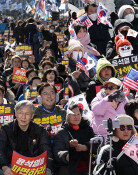Kickstart pension reform with 13% premium rate hike
Kickstart pension reform with 13% premium rate hike
Posted January. 31, 2025 07:28,
Updated January. 31, 2025 07:28
The stalled pension reform process resumed during the Lunar New Year holidays as the leadership of the ruling and opposition parties expressed their commitment to moving forward with the reform. On Sunday, Democratic Party leader Lee Jae-myung proposed finalizing legislation on parametric reform—which involves adjusting the premium rate (the amount of money paid) and the income replacement rate (the amount received in old age)—within the next month to be followed shortly by discussions on structural reforms. “We are willing to discuss pension reform with the Democratic Party of Korea if necessary,” said Kwon Young-se, chairman of the the People Power Party's emergency committee.
There are currently eight bills in the National Assembly that aim to amend the National Pension Act, all of which include parametric reform. All eight bills propose raising the premium rate—which is split equally between individuals and employers—from the current 9% to 13%. However, the proposed income replacement rate varies, ranging from a financial stabilization plan that maintains the current 40% to an income guarantee plan that increases it to 50%. In addition, the ruling party's position is that structural reform should follow to link basic, retirement, and individual pensions rather than merely adjusting the parameters. Even if the ruling and opposition parties sit down at the negotiating table for pension reform, reaching a consensus to amend the law will not be easy.
The pension reform bill collapsed at the end of the 21st National Assembly in May last year because differences over the income replacement rate were not narrowed. The government and the ruling party were on the verge of agreeing on a 13% premium rate and a 44% income replacement rate at the time. Still, the ruling party scrapped it, saying, “What is the point of delaying the depletion of the pension fund by seven or eight years?” The delay in pension reform has caused pension debt to balloon by 88.5 billion won per day and 2.75 trillion won per month. It makes sense to first implement the 13% premium rate hike that the ruling and opposition parties agreed on and then address the income replacement rate adjustment and structural reforms in stages afterward.
According to the Ministry of Health and Welfare, in order to receive a pension with a 40% income replacement rate in old age, the premium rate needs to be 19.7% to balance the budget. Even the 13% and 40% proposal in the ruling party's financial stability plan would only delay the fund's depletion by 10 years, making it difficult to ensure the sustainability of the pension system. Until now, there has been no issue because there have been few pension recipients and many people paying insurance premiums. However, due to the low birth rate and aging population, the pension fund balance is projected to turn into a deficit by 2041, and the fund is expected to run out by 2057. We must remember that the fastest reform is the best one.







